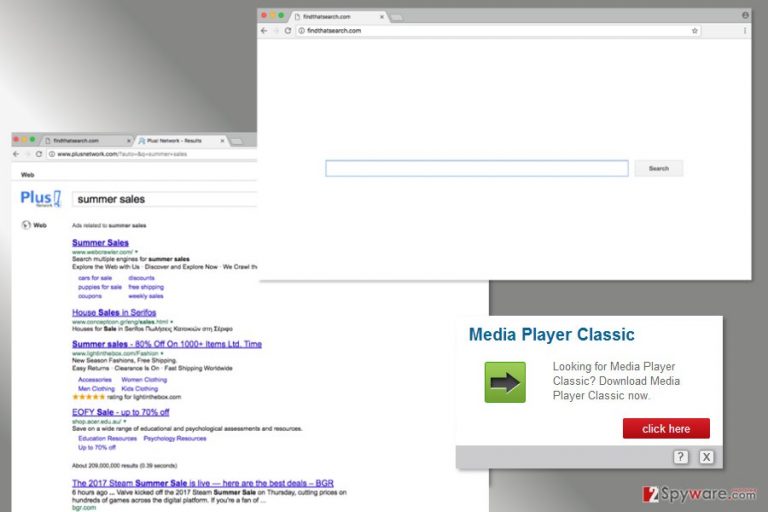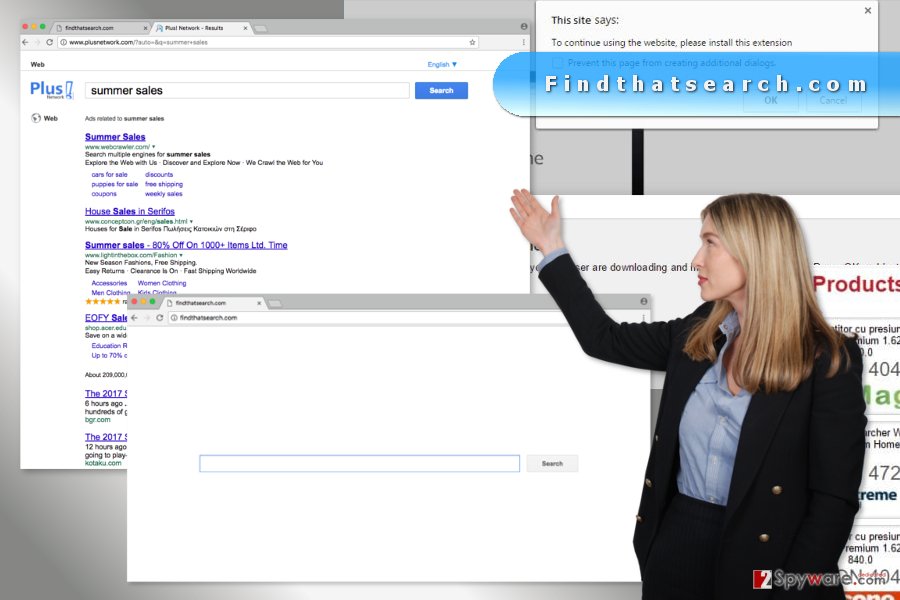Findthatsearch.com virus (Removal Guide) - Chrome, Firefox, IE, Edge
Findthatsearch.com virus Removal Guide
What is Findthatsearch.com virus?
Findthatsearch.com – a dubious search tool that might alter search results

Findthatsearch.com is a problematic search engine that spreads as a potentially unwanted program (PUP) in software bundles. On the affected computer it might alter browser’s settings and set its domain as default homepage and search engine. For this reason, it is known as a browser hijacker.
Once you type keywords into a search box, it redirects to Plus Network results page. Nevertheless, this search service is available in multiple languages, such as Estonian, Spanish[1] or Chinese; this program is still an untrustful search engine.
Undoubtedly, we all expect from search engines to deliver accurate results. However, Findthatsearch.com might alter search results. Instead of organic links, in the top of the results, you might find numerous online ads and sponsored links. Thus, users can be easily tricked into visiting irrelevant and misleading websites.
While you might be browsing through a suspicious online shop or visiting other shady site, developers of the program generate revenue. The main purpose of so-called Findthatsearch.com virus is to profit from advertising. Clicks on ads and sponsored links help developers to fulfill their pockets. Meanwhile, you might encounter various cyber threats.
The research has shown that some of the commercial content might redirect to misleading and high-risk websites where cybercriminals might be waiting for you.
There’s no doubt that you should protect your privacy and computer by terminating the hijacker. The best way to remove Findthatsearch.com is to employ reputable anti-malware program, such as FortectIntego.
The main page of the search engine has only a search box. The Privacy Policy or End User License Agreement (EULA)[2] are not provided.
The truth is that if you do not see these documents, you should use particular software or service. It’s not reliable and might pose a risk to your privacy.
Browser hijackers usually are capable of tracking browsing-related and non-personally identifiable information about users. Thus, Findthatsearch.com might do the same.
Usually, aggregated details are used for creating user’s profile and delivering personalized ads.[3] However, collected data might be shared or even sold to various third-parties, including advertising networks. As a result, your browser and inbox might be flooded with suspicious commercial content.
In some cases, suspicious applications are capable of tracking personally identifiable information too. Thus, it may lead to privacy-related issues or even identity theft. That’s why Findthatsearch.com removal should be your priority.

Your browser might get hijacked after installation of a free program
Findthatsearch.com hijack might occur after installing a new video player, PDF converter or any other free program that is available on various Internet sites or torrents.
The hijacker spreads like any other PUP – bundled with freeware and shareware. Thus, if you have recently installed a new program, it may have brought hijacker to your computer. However, you should not blame the program.
The hijacker can only enter the system if a user gives it permission. It may sound like a surprise, but you gave indirect permission when installing a new program using “Quick” or “Recommended” installation wizard. The problem is that these settings do not reveal about additional apps that might have been included in the package.
To avoid installation of undesired apps, you always have to choose “Custom” or “Advanced” settings, and once you see the list of pre-selected entries, you have to untick them.
If you haven’t done it, now you’re dealing with a hijacked web browser, suspicious Findthatsearch.com redirect problems and inability to customize your browser as you want to.
Findthatsearch.com elimination steps
Probably, you have already tried to change your homepage, and these attempts failed. Indeed, you need to work harder to get back access to the browser.
To remove Findthatsearch.com, you have to find the hijacker and delete it together with all its components. In other words, you have to investigate the system. If this task sounds challenging, you should look up to the manual removal instructions below. It’s not as hard as it may seem.
However, if you want quicker Findthatsearch.com removal solution, you should opt for the automatic elimination option. Install reputable anti-malware and scan the device.
You may remove virus damage with a help of FortectIntego. SpyHunter 5Combo Cleaner and Malwarebytes are recommended to detect potentially unwanted programs and viruses with all their files and registry entries that are related to them.
Getting rid of Findthatsearch.com virus. Follow these steps
Uninstall from Windows
By following the instructions below, you have to investigate the system and remove all the programs that might be related to the hijacker.
Instructions for Windows 10/8 machines:
- Enter Control Panel into Windows search box and hit Enter or click on the search result.
- Under Programs, select Uninstall a program.

- From the list, find the entry of the suspicious program.
- Right-click on the application and select Uninstall.
- If User Account Control shows up, click Yes.
- Wait till uninstallation process is complete and click OK.

If you are Windows 7/XP user, proceed with the following instructions:
- Click on Windows Start > Control Panel located on the right pane (if you are Windows XP user, click on Add/Remove Programs).
- In Control Panel, select Programs > Uninstall a program.

- Pick the unwanted application by clicking on it once.
- At the top, click Uninstall/Change.
- In the confirmation prompt, pick Yes.
- Click OK once the removal process is finished.
Delete from macOS
Follow the steps below to get rid of suspicious apps that might be responsible for hijacking your browser.
Remove items from Applications folder:
- From the menu bar, select Go > Applications.
- In the Applications folder, look for all related entries.
- Click on the app and drag it to Trash (or right-click and pick Move to Trash)

To fully remove an unwanted app, you need to access Application Support, LaunchAgents, and LaunchDaemons folders and delete relevant files:
- Select Go > Go to Folder.
- Enter /Library/Application Support and click Go or press Enter.
- In the Application Support folder, look for any dubious entries and then delete them.
- Now enter /Library/LaunchAgents and /Library/LaunchDaemons folders the same way and terminate all the related .plist files.

Remove from Microsoft Edge
Reset Microsoft Edge in order to get rid of the hijacker and tracking cookies that may have been installed as well.
Delete unwanted extensions from MS Edge:
- Select Menu (three horizontal dots at the top-right of the browser window) and pick Extensions.
- From the list, pick the extension and click on the Gear icon.
- Click on Uninstall at the bottom.

Clear cookies and other browser data:
- Click on the Menu (three horizontal dots at the top-right of the browser window) and select Privacy & security.
- Under Clear browsing data, pick Choose what to clear.
- Select everything (apart from passwords, although you might want to include Media licenses as well, if applicable) and click on Clear.

Restore new tab and homepage settings:
- Click the menu icon and choose Settings.
- Then find On startup section.
- Click Disable if you found any suspicious domain.
Reset MS Edge if the above steps did not work:
- Press on Ctrl + Shift + Esc to open Task Manager.
- Click on More details arrow at the bottom of the window.
- Select Details tab.
- Now scroll down and locate every entry with Microsoft Edge name in it. Right-click on each of them and select End Task to stop MS Edge from running.

If this solution failed to help you, you need to use an advanced Edge reset method. Note that you need to backup your data before proceeding.
- Find the following folder on your computer: C:\\Users\\%username%\\AppData\\Local\\Packages\\Microsoft.MicrosoftEdge_8wekyb3d8bbwe.
- Press Ctrl + A on your keyboard to select all folders.
- Right-click on them and pick Delete

- Now right-click on the Start button and pick Windows PowerShell (Admin).
- When the new window opens, copy and paste the following command, and then press Enter:
Get-AppXPackage -AllUsers -Name Microsoft.MicrosoftEdge | Foreach {Add-AppxPackage -DisableDevelopmentMode -Register “$($_.InstallLocation)\\AppXManifest.xml” -Verbose

Instructions for Chromium-based Edge
Delete extensions from MS Edge (Chromium):
- Open Edge and click select Settings > Extensions.
- Delete unwanted extensions by clicking Remove.

Clear cache and site data:
- Click on Menu and go to Settings.
- Select Privacy, search and services.
- Under Clear browsing data, pick Choose what to clear.
- Under Time range, pick All time.
- Select Clear now.

Reset Chromium-based MS Edge:
- Click on Menu and select Settings.
- On the left side, pick Reset settings.
- Select Restore settings to their default values.
- Confirm with Reset.

Remove from Mozilla Firefox (FF)
Findthatsearch.com might not be the only PUP installed to Mozilla Firefox. Open the list of extensions and uninstall all unknown entries. Then reset the browser.
Remove dangerous extensions:
- Open Mozilla Firefox browser and click on the Menu (three horizontal lines at the top-right of the window).
- Select Add-ons.
- In here, select unwanted plugin and click Remove.

Reset the homepage:
- Click three horizontal lines at the top right corner to open the menu.
- Choose Options.
- Under Home options, enter your preferred site that will open every time you newly open the Mozilla Firefox.
Clear cookies and site data:
- Click Menu and pick Settings.
- Go to Privacy & Security section.
- Scroll down to locate Cookies and Site Data.
- Click on Clear Data…
- Select Cookies and Site Data, as well as Cached Web Content and press Clear.

Reset Mozilla Firefox
If clearing the browser as explained above did not help, reset Mozilla Firefox:
- Open Mozilla Firefox browser and click the Menu.
- Go to Help and then choose Troubleshooting Information.

- Under Give Firefox a tune up section, click on Refresh Firefox…
- Once the pop-up shows up, confirm the action by pressing on Refresh Firefox.

Remove from Google Chrome
Findthatsearch.com browser hijacker might be related to various extensions that may have been installed to your browser. Thus check the list of Chrome's extensions.
Delete malicious extensions from Google Chrome:
- Open Google Chrome, click on the Menu (three vertical dots at the top-right corner) and select More tools > Extensions.
- In the newly opened window, you will see all the installed extensions. Uninstall all the suspicious plugins that might be related to the unwanted program by clicking Remove.

Clear cache and web data from Chrome:
- Click on Menu and pick Settings.
- Under Privacy and security, select Clear browsing data.
- Select Browsing history, Cookies and other site data, as well as Cached images and files.
- Click Clear data.

Change your homepage:
- Click menu and choose Settings.
- Look for a suspicious site in the On startup section.
- Click on Open a specific or set of pages and click on three dots to find the Remove option.
Reset Google Chrome:
If the previous methods did not help you, reset Google Chrome to eliminate all the unwanted components:
- Click on Menu and select Settings.
- In the Settings, scroll down and click Advanced.
- Scroll down and locate Reset and clean up section.
- Now click Restore settings to their original defaults.
- Confirm with Reset settings.

Delete from Safari
Follow the instructions to remove hijacker from the Safari entirely.
Remove unwanted extensions from Safari:
- Click Safari > Preferences…
- In the new window, pick Extensions.
- Select the unwanted extension and select Uninstall.

Clear cookies and other website data from Safari:
- Click Safari > Clear History…
- From the drop-down menu under Clear, pick all history.
- Confirm with Clear History.

Reset Safari if the above-mentioned steps did not help you:
- Click Safari > Preferences…
- Go to Advanced tab.
- Tick the Show Develop menu in menu bar.
- From the menu bar, click Develop, and then select Empty Caches.

After uninstalling this potentially unwanted program (PUP) and fixing each of your web browsers, we recommend you to scan your PC system with a reputable anti-spyware. This will help you to get rid of Findthatsearch.com registry traces and will also identify related parasites or possible malware infections on your computer. For that you can use our top-rated malware remover: FortectIntego, SpyHunter 5Combo Cleaner or Malwarebytes.
How to prevent from getting stealing programs
Stream videos without limitations, no matter where you are
There are multiple parties that could find out almost anything about you by checking your online activity. While this is highly unlikely, advertisers and tech companies are constantly tracking you online. The first step to privacy should be a secure browser that focuses on tracker reduction to a minimum.
Even if you employ a secure browser, you will not be able to access websites that are restricted due to local government laws or other reasons. In other words, you may not be able to stream Disney+ or US-based Netflix in some countries. To bypass these restrictions, you can employ a powerful Private Internet Access VPN, which provides dedicated servers for torrenting and streaming, not slowing you down in the process.
Data backups are important – recover your lost files
Ransomware is one of the biggest threats to personal data. Once it is executed on a machine, it launches a sophisticated encryption algorithm that locks all your files, although it does not destroy them. The most common misconception is that anti-malware software can return files to their previous states. This is not true, however, and data remains locked after the malicious payload is deleted.
While regular data backups are the only secure method to recover your files after a ransomware attack, tools such as Data Recovery Pro can also be effective and restore at least some of your lost data.
- ^ Losvirus. Losvirus. Spanish website about computer viruses and their removal.
- ^ End-user license agreement. Wikipedia. The free encyclopedia.
- ^ Kimberlee Morrison. Internet Users Want a More Personalized Ad Experience (Report). AdWeek. Breaking News in Advertising, Media and Technology.
